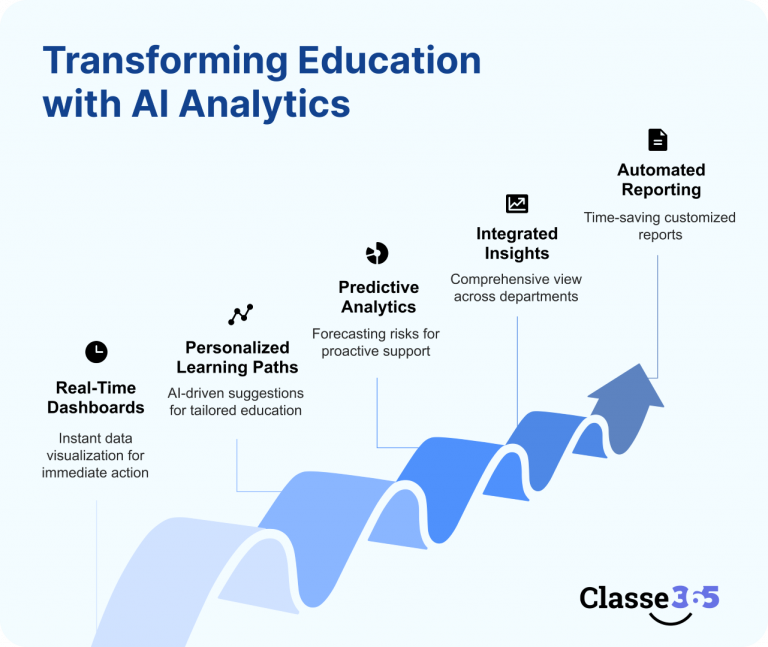Introduction: Why Traditional Metrics Aren’t Enough Anymore
Schools often rely on exam results, attendance sheets, or teacher observations to measure performance. But these static metrics don’t always reflect the full picture — especially in a dynamic digital learning environment.
Without real-time, actionable data, institutions struggle to identify what’s truly effective. Are students engaged? Is the curriculum meeting learning goals? Where are the bottlenecks? Traditional reporting methods leave too many questions unanswered.
To move from guesswork to insight, schools are increasingly turning to AI-powered analytics.
The Gaps in Conventional School Reporting
1. Delayed and Retrospective Insights
Traditional reporting often comes too late. By the time data is compiled and shared, opportunities for intervention have already passed.
2. One-Size-Fits-All Metrics
Every learner is different, but conventional metrics fail to reflect this. Standardized data overlooks individual student needs and performance fluctuations.
3. Manual Reporting is Prone to Error
Spreadsheet-driven processes are not only time-consuming but also vulnerable to inconsistencies and mistakes — leading to misinformed decisions.
4. No Holistic View of Student Performance
Most systems look at academic results in isolation. Without integrating data from attendance, engagement, behavior, and assessments, it’s hard to spot patterns or make meaningful improvements.
How AI Analytics Changes the Game
1. Real-Time Dashboards for Immediate Action
AI dashboards aggregate data from various systems — attendance, assessments, participation — and visualize trends instantly. School leaders no longer have to wait weeks for insights.
2. Learning Pathway Suggestions Powered by AI
By analyzing student performance and learning behavior, AI tools can recommend personalized next steps — from remedial resources to enrichment activities — that boost outcomes.
3. Predictive Analytics for Proactive Support
Advanced models can forecast risks, such as potential dropouts or underperformance, allowing timely interventions that improve retention and success rates.
4. Integrated Insights Across Departments
Instead of fragmented insights, AI-driven analytics delivers a comprehensive 360-degree view by bringing together academic, behavioral, and operational data — empowering educators and administrators to make well-informed decisions.
5. Automated Reporting That Saves Time
AI systems can generate customized reports for teachers, principals, and boards — reducing workload and making information easier to act upon.

A Real-World Impact: AI Insights in Action
“A K-12 school in the Middle East used AI dashboards to identify a 20% drop in engagement during midterm weeks — leading them to revise their scheduling and boost student participation by 30%.”
AI analytics not only highlighted the issue but suggested adaptive learning strategies that helped close the gap.
In Short
- Static reports are outdated — schools need real-time, AI-powered insights to stay ahead.
- AI dashboards help identify what’s working, highlight what needs attention, and provide actionable solutions.
- Predictive analytics and personalized learning paths support better academic outcomes and operational efficiency.
- Schools using AI analytics report better planning, stronger engagement, and improved learning outcomes.
Conclusion: Where Classe365 Comes In
If your school is ready to stop guessing and start acting on real insights, it’s time to explore an AI-powered analytics solution.
Classe365’s built-in analytics suite offers live dashboards, predictive insights, and AI-suggested learning pathways — empowering schools to make informed, timely decisions that drive better outcomes.
👉 Book a free demo to see how data-backed decisions can reshape your school’s future.
Frequently Asked Questions
What is AI analytics in education?
AI analytics uses algorithms to analyze large volumes of education data in real time — revealing trends, predicting outcomes, and recommending actions.
How do AI dashboards help schools?
They offer instant visibility into performance metrics like attendance, assessment scores, and engagement — enabling proactive decisions.
What are AI-powered learning pathways?
These are personalized recommendations generated by AI based on each student’s performance and needs — helping teachers tailor instruction.
Is AI analytics difficult to implement in schools?
Not necessarily. Modern platforms integrate easily with existing systems and provide intuitive dashboards that require minimal training.
